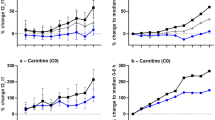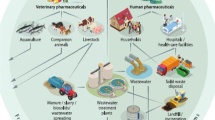Abstract
This study centres on the prevalence of new psychoactive substances (NPS) stimulant use, and its relevance as a cause of death amongst individuals between the ages of 12 and 35 in the greater Cologne area. An automated solid-phase extraction-liquid chromatography-tandem mass spectrometry method was developed for the determination of 97 stimulants in urine (including conventional stimulants, e.g. amphetamine and MDMA), of which 68 analytes were fully validated for quantification. Samples of urine or kidney tissue (in cases where urine was unavailable) of 268 deceased were collected, during autopsy, between January 2011 and May 2017 and analyzed. Blood (if available) was also investigated in cases where urine/kidney samples were tested positive for NPS. An intake of stimulants (including NPS stimulants) was proven in 50 cases. In 33 cases, only conventional stimulants were detected. A total of 17 cases were tested positive for NPS. Of the 17 NPS-positive cases, 13 were also tested positive for other conventional drugs of abuse (mostly amphetamine and MDMA). In six NPS-positive cases, at least three different NPS were proven to be ingested. Due to the determined blood concentrations, NPS was assigned as the leading cause of death, or of toxicological relevance, in the cause of death in only 5 cases. In two of the cases, NPS was judged to be a component of a multidrug poisoning, but of minor relevance.
Similar content being viewed by others
References
Global Synthetic Drugs Assessment (2014) Amphetamine-type stimulants and new psychoactive substances. United Nations publication, New York
European Monitoring Centre for Drugs and Drug Addiction (2018) European Drug Report 2018: trends and developments. Publications Office of the European Union, Luxembourg. https://doi.org/10.2810/688395
O’Byrne PM, Kavanagh PV, McNamara SM, Stokes SM (2013) Screening of stimulants including designer drugs in urine using a liquid chromatography tandem mass spectrometry system. J Anal Toxicol 37(2):64–73. https://doi.org/10.1093/jat/bks091
Favretto D, Pascali JP, Tagliaro F (2013) New challenges and innovation in forensic toxicology: focus on the “New Psychoactive Substances”. J Chromatogr A 1287:84–95. https://doi.org/10.1016/j.chroma.2012.12.049
Pichini S, Pujadas M, Marchei E, Pellegrini M, Fiz J, Pacifici R, Zuccaro P, Farré M, de la Torre R (2008) Liquid chromatography–atmospheric pressure ionization electrospray mass spectrometry determination of “hallucinogenic designer drugs” in urine of consumers. J Pharm Biomed Anal 47(2):335–342. https://doi.org/10.1016/j.jpba.2007.12.039
Peters FT (2014) Recent developments in urinalysis of metabolites of new psychoactive substances using LC–MS. Bioanalysis 6(15):2083–2107. https://doi.org/10.4155/bio.14.168
Lehmann S, Kieliba T, Beike J, Thevis M, Mercer-Chalmers-Bender K (2017) Determination of 74 new psychoactive substances in serum using automated in-line solid-phase extraction-liquid chromatography-tandem mass spectrometry. J Chromatogr B 1064:124–138. https://doi.org/10.1016/j.jchromb.2017.09.003
Uralets V, Rana S, Morgan S, Ross W (2014) Testing for designer stimulants: metabolic profiles of 16 synthetic cathinones excreted free in human urine. J Anal Toxicol 38(5):233–241. https://doi.org/10.1093/jat/bku021
Thornton SL, Gerona RR, Tomaszewski CA (2012) Psychosis from a bath salt product containing flephedrone and MDPV with serum, urine, and product quantification. J Med Toxicol 8(3):310–313. https://doi.org/10.1007/s13181-012-0232-4
Helander A, Beck O, Hägerkvist R, Hultén P (2013) Identification of novel psychoactive drug use in Sweden based on laboratory analysis–initial experiences from the STRIDA project. Scand J Clin Lab Invest 73(5):400–406. https://doi.org/10.3109/00365513.2013.793817
Lusthof KJ, Oosting R, Maes A, Verschraagen M, Dijkhuizen A, Sprong AG (2011) A case of extreme agitation and death after the use of mephedrone in The Netherlands. Forensic Sci Int 206(1):e93–e95. https://doi.org/10.1016/j.forsciint.2010.12.014
Maskell PD, De Paoli G, Seneviratne C, Pounder DJ (2011) Mephedrone (4-methylmethcathinone)-related deaths. J Anal Toxicol 35(3):188–191. https://doi.org/10.1093/anatox/35.3.188
Liveri K, Constantinou MA, Afxentiou M, Kanari P (2016) A fatal intoxication related to MDPV and pentedrone combined with antipsychotic and antidepressant substances in Cyprus. Forensic Sci Int 265:160–165. https://doi.org/10.1016/j.forsciint.2016.02.017
Gil D, Adamowicz P, Skulska A, Tokarczyk B, Stanaszek R (2013) Analysis of 4-MEC in biological and non-biological material—three case reports. Forensic Sci Int 228(1):e11–e15. https://doi.org/10.1016/j.forsciint.2013.03.011
Smith P, Cole R, Hamilton S, West K, Morley S, Maskell P (2016) Reporting two fatalities associated with the use of 4-methylethcathinone (4-MEC) and a review of the literature. J Anal Toxicol 40(7):553–560. https://doi.org/10.1093/jat/bkw061
Musshoff F, Padosch S, Steinborn S, Madea B (2004) Fatal blood and tissue concentrations of more than 200 drugs. Forensic Sci Int 142(2-3):161–210. https://doi.org/10.1016/j.forsciint.2004.02.017
Carvalho M, Carmo H, Costa VM, Capela JP, Pontes H, Remião F, Carvalho F, de Lourdes BM (2012) Toxicity of amphetamines: an update. Arch Toxicol 86(8):1167–1231. https://doi.org/10.1007/s00204-012-0815-5
Lehmann S, Schulze B, Thomas A, Kamphausen T, Thevis M, Rothschild MA, Mercer-Chalmers-Bender K (2018) Organ distribution of 4-MEC, MDPV, methoxetamine and α-PVP: comparison of QuEChERS and SPE. Forensic Toxicol 36(2):320–333. https://doi.org/10.1007/s11419-018-0408-y
Gaunitz F, Schürenkamp J, Rostamzadeh A, Konkol C, Thevis M, Rothschild MA, Mercer-Chalmers-Bender K (2017) Analysis of taxine B/isotaxine B in a plasma specimen by LC–MS/MS in a case of fatal poisoning: concealed suicide by ingestion of yew (Taxus L.) leaves of a patient with a long-term history of borderline personality disorder. Forensic Toxicol 35:421–427. https://doi.org/10.1007/s11419-017-0355-z
Pragst F, Herzler M, Erxleben B-T (2004) Systematic toxicological analysis by high-performance liquid chromatography with diode array detection (HPLC-DAD). Clin Chem Lab Med 42(11):1325–1340. https://doi.org/10.1515/CCLM.2004.251
Schulz M, Iwersen-Bergmann S, Andresen H, Schmoldt A (2012) Therapeutic and toxic blood concentrations of nearly 1,000 drugs and other xenobiotics. Crit Care 16:R136 (4). https://doi.org/10.1186/cc11441
Andreasen MF, Telving R, Rosendal I, Eg MB, Hasselstrøm JB, Andersen LV (2015) A fatal poisoning involving 25C-NBOMe. Forensic Sci Int 251:e1–e8. https://doi.org/10.1016/j.forsciint.2015.03.012
Gee P, Schep LJ, Jensen BP, Moore G, Barrington S (2016) Case series: toxicity from 25B-NBOMe–a cluster of N-bomb cases. Clin Toxicol 54(2):141–146. https://doi.org/10.3109/15563650.2015.1115056
Poklis JL, Devers KG, Arbefeville EF, Pearson JM, Houston E, Poklis A (2014) Postmortem detection of 25I-NBOMe [2-(4-iodo-2, 5-dimethoxyphenyl)-N-[(2-methoxyphenyl) methyl] ethanamine] in fluids and tissues determined by high performance liquid chromatography with tandem mass spectrometry from a traumatic death. Forensic Sci Int 234:e14–e20. https://doi.org/10.1016/j.forsciint.2013.10.015
Vevelstad M, Øiestad EL, Middelkoop G, Hasvold I, Lilleng P, Delaveris GJM, Eggen T, Mørland J, Arnestad M (2012) The PMMA epidemic in Norway: comparison of fatal and non-fatal intoxications. Forensic Sci Int 219(1):151–157. https://doi.org/10.1016/j.forsciint.2011.12.014
Nicol JJ, Yarema MC, Jones GR, Martz W, Purssell RA, MacDonald JC, Wishart I, Durigon M, Tzemis D, Buxton JA (2015) Deaths from exposure to paramethoxymethamphetamine in Alberta and British Columbia, Canada: a case series. Can Med Assoc J 3(1):E83–E90. https://doi.org/10.9778/cmajo.20140070
European Monitoring Centre for Drugs and Drug Addiction (2016) Recent changes in Europe’s MDMA/ecstasy market. Publications Office of the European Union, Luxembourg. https://doi.org/10.2810/817237
Rohanova M, Balikova M (2009) Studies on distribution and metabolism of para-methoxymethamphetamine (PMMA) in rats after subcutaneous administration. Toxicology 259(1):61–68. https://doi.org/10.1016/j.tox.2009.02.003
WHO Expert Committee on Drug Dependence (2015) para-Methoxymethylamphetamine (PMMA). Critical Review Report. Agenda item 5.6. https://www.who.int/medicines/access/controlled-substances/5.6_PMMA_CRev.pdf. Accessed 03 Jan 2019
Elliott S, Evans J (2014) A 3-year review of new psychoactive substances in casework. Forensic Sci Int 243:55–60. https://doi.org/10.1016/j.forsciint.2014.04.017
Corkery JM, Elliott S, Schifano F, Corazza O, Ghodse AH (2012) 2-DPMP (desoxypipradrol, 2-benzhydrylpiperidine, 2-phenylmethylpiperidine) and D2PM (diphenyl-2-pyrrolidin-2-yl-methanol, diphenylprolinol): A preliminary review. Prog Neuro-Psychopharmacol Biol Psychiatry 39(2):253–258. https://doi.org/10.1016/j.pnpbp.2012.05.021
Corazza O, Schifano F, Simonato P, Fergus S, Assi S, Stair J, Corkery J, Trincas G, Deluca P, Davey Z (2012) Phenomenon of new drugs on the Internet: the case of ketamine derivative methoxetamine. Hum Psychopharmacol Clin Exp 27(2):145–149. https://doi.org/10.1002/hup.1242
Kriikku P, Wilhelm L, Rintatalo J, Hurme J, Kramer J, Ojanperä I (2013) Prevalence and blood concentrations of desoxypipradrol (2-DPMP) in drivers suspected of driving under the influence of drugs and in post-mortem cases. Forensic Sci Int 226(1-3):146–151. https://doi.org/10.1016/j.forsciint.2012.12.021
Chiappini S, Claridge H, Corkery JM, Goodair C, Loi B, Schifano F (2015) Methoxetamine-related deaths in the UK: an overview. Hum Psychopharmacol Clin Exp 30(4):244–248. https://doi.org/10.1002/hup.2422
Adamowicz P, Zuba D (2015) Fatal intoxication with methoxetamine. J Forensic Sci 60:S264–S268. https://doi.org/10.1111/1556-4029.12594
Wikström M, Thelander G, Dahlgren M, Kronstrand R (2013) An accidental fatal intoxication with methoxetamine. J Anal Toxicol 37(1):43–46. https://doi.org/10.1093/jat/bks086
Imbert L, Boucher A, Delhome G, Cueto T, Boudinaud M, Maublanc J, Dulaurent S, Descotes J, Lachâtre G, Gaulier J-M (2014) Analytical findings of an acute intoxication after inhalation of methoxetamine. J Anal Toxicol 38(7):410–415. https://doi.org/10.1093/jat/bku052
Shields JE, Dargan PI, Wood DM, Puchnarewicz M, Davies S, Waring WS (2012) Methoxetamine associated reversible cerebellar toxicity: three cases with analytical confirmation. Clin Toxicol 50(5):438–440. https://doi.org/10.3109/15563650.2012.683437
Wood DM, Davies S, Puchnarewicz M, Johnston A, Dargan PI (2012) Acute toxicity associated with the recreational use of the ketamine derivative methoxetamine. Eur J Clin Pharmacol 68(5):853–856. https://doi.org/10.1007/s00228-011-1199-9
Lehmann S, Sczyslo A, Froch-Cortis J, Rothschild MA, Thevis M, Andresen-Streichert H, Mercer-Chalmers-Bender K (2019) Organ distribution of diclazepam, pyrazolam and 3-fluorophenmetrazine. Forensic Sci Int 303(109959). https://doi.org/10.1016/j.forsciint.2019.109959
Lehmann S, Teifel D, Rothschild MA, Andresen-Streichert H (2018) Tödliche Intoxikation mit dem Designer-Opioid U-47700. Toxichem Krimtech 85(1):36
Cheney BV, Szmuszkovicz J, Lahti RA, Zichi DA (1985) Factors affecting binding of trans-N-[2-(methylamino) cyclohexyl] benzamides at the primary morphine receptor. J Med Chem 28(12):1853–1864
Mohr AL, Friscia M, Papsun D, Kacinko SL, Buzby D, Logan BK (2016) Analysis of novel synthetic opioids U-47700, U-50488 and furanyl fentanyl by LC–MS/MS in postmortem casework. J Anal Toxicol 40(9):709–717. https://doi.org/10.1093/jat/bkw086
Adamowicz P, Gieroń J, Gil D, Lechowicz W, Skulska A, Tokarczyk B (2016) The prevalence of new psychoactive substances in biological material–a three-year review of casework in Poland. Drug Test Anal 8(1):63–70. https://doi.org/10.1002/dta.1924
Adamowicz P, Tokarczyk B (2016) Simple and rapid screening procedure for 143 new psychoactive substances by liquid chromatography-tandem mass spectrometry. Drug Test Anal 8(7):652–667. https://doi.org/10.1002/dta.1815
Tsujikawa K, Mikuma T, Kuwayama K, Miyaguchi H, Kanamori T, Iwata YT, Inoue H (2012) Degradation pathways of 4-methylmethcathinone in alkaline solution and stability of methcathinone analogs in various pH solutions. Forensic Sci Int 220(1):103–110. https://doi.org/10.1016/j.forsciint.2012.02.005
Al-Saffar Y, Stephanson NN, Beck O (2013) Multicomponent LC-MS/MS screening method for detection of new psychoactive drugs, legal highs, in urine-experience from the Swedish population. J Chromatogr B 930:112–120. https://doi.org/10.1016/j.jchromb.2013.04.043
Concheiro M, Castaneto M, Kronstrand R, Huestis MA (2015) Simultaneous determination of 40 novel psychoactive stimulants in urine by liquid chromatography–high resolution mass spectrometry and library matching. J Chromatogr A 1397:32–42. https://doi.org/10.1016/j.chroma.2015.04.002
Acknowledgements
The authors wish to thank Scientific Instruments Manufacturer GmbH (Oberhausen, Germany) for generously providing the ITSP-SPE system for this research. We thank Dr. June Mercer-Chalmers-Bender for editorial support. This work was supported by the Federal Ministry for Economic Affairs and Energy on the basis of a decision by the German Bundestag, grand no. KF2429613MD3.
Author information
Authors and Affiliations
Corresponding author
Ethics declarations
Ethical approval
All experiments comply with the current laws of the Federal Republic of Germany. All performed analytical tests were part of the state prosecutors’ requested investigation on the cause of death, and are therefore not subject to the requirements for ethical approval. The state prosecutor gave his approval to publish the results under the condition of complete anonymization of individual data. The article does not contain any studies on animals performed by any of the authors.
Conflict of interest
The authors declare that they have no conflict of interest.
Additional information
Publisher’s note
Springer Nature remains neutral with regard to jurisdictional claims in published maps and institutional affiliations.
Electronic supplementary material
ESM 1
(DOCX 119 kb)
Rights and permissions
About this article
Cite this article
Lehmann, S., Kieliba, T., Thevis, M. et al. Fatalities associated with NPS stimulants in the Greater Cologne area. Int J Legal Med 134, 229–241 (2020). https://doi.org/10.1007/s00414-019-02193-z
Received:
Accepted:
Published:
Issue Date:
DOI: https://doi.org/10.1007/s00414-019-02193-z




